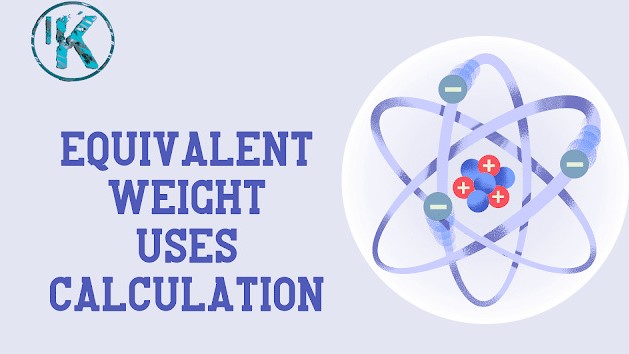Equivalent Weight
Equivalent weight is the Mass of on Equivalent.
That is the mass of a given substance which will combine with or displace a fixed quantity of another substance.
The use of equivalent weights in general chemistry has largely been superseded by the use of Molar Masses.
Uses
Equivalent weight is a concept widely used in chemistry, particularly in the context of stoichiometry, redox reactions, and acid-base reactions. Here are some specific uses of equivalent weight :
Equivalent weight is used in the calculation of Normality.
01. Redox Reactions
Equivalent weight is used to balance redox equations by ensuring that the number of equivalents of electrons transferred on both sides of the reaction is equal.
Determining Oxidation States: Equivalent weight helps in determining the oxidation state of elements involved in redox reactions.

02. Electrochemistry
Calculating Faraday’s Constant: Equivalent weight is used to calculate Faraday’s constant, which is essential in electrochemical calculations, such as determining the amount of substance deposited or consumed during electrolysis.

03. Quantitative Analysis
Titrations: Equivalent weight is used in acid-base titrations, where it helps in calculating the amount of acid or base reacted with a given volume of the titrant.
04. Molecular Weight Determination
Polyfunctional Compounds: Equivalent weight is helpful when dealing with polyfunctional compounds where multiple acidic or basic groups are present. It allows for a consistent comparison of reactivity.
05. Synthesis and Stoichiometry
Equivalent weight simplifies calculations involving reactant amounts in chemical reactions, providing a direct relationship between the amount of a substance and the moles of electrons involved.
06. Analytical Chemistry
Equivalent weight is used in gravimetric analysis methods, where the mass of a precipitate is used to determine the amount of substance present.
Formula
\[Equivalent Weight=\frac{Molecular\;Weight}{Valency}\]
Expand Your Knowledge on [Why Plastic Buckets Are a Hidden Hazard in Plants]
Calculation
1.) Molar mass of NaOH = 23 g/mol (for Na) + 16 g/mol (for O) + 1 g/mol (for H)
= 40/1
= 40 g/mol
2.) Molar mass of HCl = 1 g/mol (for H) + 35.5 g/mol
(for Cl)
= 36.5/1
= 36.5 g/mol
3.) Molar mass of H2SO4
= (2×1) g/mol (forH2) + 32 g/mol (for S) + (16×4) g/mol (for O4)
= 2 + 32 + 64
= 98/2
= 49 g/mol
4.) Molar mass of KMnO4
= 39 g/mol (for K) + 55 g/mol (for Mn) + (16×4) g/mol (for O4)
= 158/1
= 158 g/ mol
5.) Molar mass of H2O2
= (2×1) (for H2) + (16×2) (for O
= 2+32
= 34/2
= 17 g/mol
Example of Acids
| No | Name of Acids | Formula | Basicity | Molecular Weight/Valency | Equivalent Weight |
| 01 | Hydrochloric Acid | HCL | 1 | 35.5/1 | 35.5 |
| 02 | Nitric Acid | HNO3 | 1 | 63/1 | 63 |
| 03 | Sulphuric Acid | H2SO4 | 2 | 98/2 | 49 |
| 04 | Acetic Acid | CH3COOH | 1 | 60/1 | 60 |
| 05 | Phosphoric Acid | H3PO4 | 3 | 98/3 | 32.66 |
| 06 | Oxalic Acid | H2C2O7 | 2 | 90/2 | 45 |
| 07 | Citric Acid | C6H8O7 | 3 | 192/3 | 64 |
| 08 | Hydrofluoric Acid | HF | 1 | 20/1 | 20 |
| 09 | Carbonic Acid | H2CO3 | 2 | 62/2 | 31 |
| 10 | Tartaric Acid | C4H6O6 | 2 | 145/2 | 75 |
Example Of Base
| No | Name of Base | Formula | Acidity | Molecular Weight/Valency | Equivalent Weight |
| 01 | Sodium Hydroxide | NaOH | 1 | 40/1 | 40 |
| 02 | Potassium Hydroxide | KOH | 1 | 56/1 | 56 |
| 03 | Calcium Hydroxide | Ca(OH)2 | 2 | 74/2 | 37 |
| 04 | Ammonium Hydroxide | NH4OH | 1 | 35/1 | 35 |
| 05 | Magnesium Hydroxide | Mg(OH)2 | 2 | 59/2 | 29 |
| 06 | Lithium Hydroxide | LiOH | 1 | 24/1 | 24 |
| 07 | Sodium Bi Carbonate | NaHCO3 | 1 | 84/1 | 84 |
| 08 | Potassium Carbonate | K2CO3 | 2 | 138/2 | 69 |
| 09 | Sodium Phosphate | Na3PO4 | 4 | 164/4 | 41 |
| 10 | Sodium Silicate | Na2SiO3 | 2 | 122/2 | 61 |
